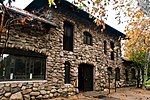Heritage Square station

Heritage Square station is an at-grade light rail station on the L Line of the Los Angeles Metro Rail system. It is located at the intersection of French Avenue and Pasadena Avenue in the western Montecito Heights neighborhood of Los Angeles.The station is named after the nearby Heritage Square Museum and is located in the lower Arroyo Seco valley between the San Rafael Hills and Mount Washington. It is adjacent to the Arroyo Seco Parkway (also known as California State Route 110 and the Pasadena Freeway). Heritage Square station opened on July 26, 2003, as part of the original Gold Line, then known as the "Pasadena Metro Blue Line" project. This station and all the other original and Foothill Extension stations will be part of the A Line upon completion of the Regional Connector project in 2022.
Excerpt from the Wikipedia article Heritage Square station (License: CC BY-SA 3.0, Authors, Images).Heritage Square station
Pasadena Avenue, Los Angeles Montecito Heights
Geographical coordinates (GPS) Address Nearby Places Show on map
Geographical coordinates (GPS)
| Latitude | Longitude |
|---|---|
| N 34.0871 ° | E -118.2126 ° |
Address
Metro Park and Ride
Pasadena Avenue
90031 Los Angeles, Montecito Heights
California, United States
Open on Google Maps









